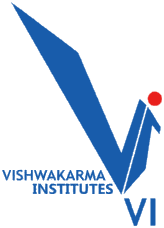Educational software is a term used for any computer software which is made for an educational purpose. It encompasses different ranges from language learning software to classroom management software to reference software. The purpose of all this software is to make some part of education more effective and efficient.
M-learning, or mobile learning, is a form of distance education where learners use portable devices such as mobile phones to learn anywhere and anytime. The portability that mobile devices provide allows for learning anywhere, hence the term "mobile" in "mobile learning." M-learning devices include computers, MP3 players, mobile phones, and tablets. M-learning can be an important part of informal learning.

Vishwakarma Institute of Technology (VIT) is an autonomous institute in Pune, Maharashtra, India. Established in 1983, the institute is affiliated with the Savitribai Phule Pune University and run by the Bansilal Ramnath Agarwal Charitable Trust. The institution is ISO 9001-2015 certified by BSI, India, and was accredited by National Assessment and Accreditation Council (NAAC), Bangalore from November 2018 until 2023.
Educational technology is the combined use of computer hardware, software, and educational theory and practice to facilitate learning. When referred to with its abbreviation, "EdTech," it often refers to the industry of companies that create educational technology. In EdTech Inc.: Selling, Automating and Globalizing Higher Education in the Digital Age, Tanner Mirrlees and Shahid Alvi (2019) argue "EdTech is no exception to industry ownership and market rules" and "define the EdTech industries as all the privately owned companies currently involved in the financing, production and distribution of commercial hardware, software, cultural goods, services and platforms for the educational market with the goal of turning a profit. Many of these companies are US-based and rapidly expanding into educational markets across North America, and increasingly growing all over the world."
Editing technology is the use of technology tools in general content areas in education in order to allow students to apply computer and technology skills to learning and problem-solving. Generally speaking, the curriculum drives the use of technology and not vice versa. Technology integration is defined as the use of technology to enhance and support the educational environment. Technology integration in the classroom can also support classroom instruction by creating opportunities for students to complete assignments on the computer rather than with normal pencil and paper. In a larger sense, technology integration can also refer to the use of an integration platform and application programming interface (API) in the management of a school, to integrate disparate SaaS applications, databases, and programs used by an educational institution so that their data can be shared in real-time across all systems on campus, thus supporting students' education by improving data quality and access for faculty and staff.
"Curriculum integration with the use of technology involves the infusion of technology as a tool to enhance the learning in a content area or multidisciplinary setting... Effective technology integration is achieved when students can select technology tools to help them obtain information on time, analyze and synthesize it, and present it professionally to an authentic audience. Technology should become an integral part of how the classroom functions—as accessible as all other classroom tools. The focus in each lesson or unit is the curriculum outcome, not the technology."
Universal Design for Learning (UDL) is an educational framework based on research in the learning sciences, including cognitive neuroscience, that guides the development of flexible learning environments and learning spaces that can accommodate individual learning differences.
The UK government's Microelectronics Education Programme ran from 1980 to 1986. It was conceived and planned by a Labour government and set up under a Conservative government during Mrs Thatcher's era. It aimed to explore how computers could be used in schools in the UK. This was a controversial time for Conservative school policies.
An intelligent tutoring system (ITS) is a computer system that imitates human tutors and aims to provide immediate and customized instruction or feedback to learners, usually without requiring intervention from a human teacher. ITSs have the common goal of enabling learning in a meaningful and effective manner by using a variety of computing technologies. There are many examples of ITSs being used in both formal education and professional settings in which they have demonstrated their capabilities and limitations. There is a close relationship between intelligent tutoring, cognitive learning theories and design; and there is ongoing research to improve the effectiveness of ITS. An ITS typically aims to replicate the demonstrated benefits of one-to-one, personalized tutoring, in contexts where students would otherwise have access to one-to-many instruction from a single teacher, or no teacher at all. ITSs are often designed with the goal of providing access to high quality education to each and every student.

The University of Peloponnese is a Greek tertiary educational institution, composed of campuses in Tripoli, Corinth, Kalamata, Nafplio, Sparta, and Patras with more than 25,000 students in 9 schools across the campuses, with the former being in turn composed of 22 departments.

Istanbul Beykent University is a foundation university in Istanbul, Turkey, teaching in English, Russian combined and Turkish with 30.000 students.
Ace Centre, previously ACE Centre is a non-profit organization in England that supports people with communications difficulties.

A Virtual Learning Environment (VLE) is a system specifically designed to facilitate the management of educational courses by teachers for their students. It predominantly relies on computer hardware and software, enabling distance learning. In North America, this concept is commonly denoted as a "Learning Management System" (LMS).
Richard Hooper CBE is a former UK civil servant. He was Deputy Chairman of OFCOM between 2002 and 2005.
The National Council for Educational Technology provided advice and support for schools and colleges in England, Wales, and Northern Ireland on educational technology, in particular the use of computers for teaching and learning.
The Council for Educational Technology was set up in 1967 by the Department of Education and Science in the UK. Initially it consisted of a large council of experts with a small administrative team whose purpose was to "advise educational services and industrial training organisations on the use of audio visual aids and media" but it quickly became more than this, developing projects, producing an academic journal BJET and advising government on setting up major computer aided learning programmes. It was amalgamated with the Microelectronics Education Support Unit (MESU) in 1989 to form the National Council for Educational Technology.

Michael J. Hannafin was professor of instructional technology and director of Learning and Performance Support Laboratory at the University of Georgia. He obtained a Ph.D. in educational technology from the Arizona State University. Along with Kyle Peck, he developed the field of computer-aided instruction as distinguished from computer-based instruction. He received the AERA SIG- IT Best Paper Award in 2007.
Information Communications Technology is usually included in the Home Economics and Livelihood Education program in grade school and taught through the Technology and Home Economics program in high school. The recent status of ICT education in the Philippines, along with other Southeast Asian countries, was surveyed by the Southeast Asian Ministers of Education Organization (SEAMEO) in 2011. Using the UNESCO model of ICT Development in Education, the countries were ranked as Emerging, Applying, Infusing or Transforming. The Philippines were ranked at the Infusing stage of integrating ICT in education, indicating that the country has integrated ICT into existing teaching, learning and administrative practices and policies. This includes components such as a national vision of ICT in education, national ICT plans and policies, complementary national ICT and education policies, professional development for teachers and school leaders, community or partnership and teaching and learning pedagogies. A 2012 study reported that public high schools in Metro Manila had a computer to student ratio of 1:63. While 88 percent of schools have internet connections, half of the students claimed not to be using it.
Educational technology in sub-Saharan Africa refers to the promotion, development and use of information and communication technologies (ICT), m-learning, media, and other technological tools to improve aspects of education in sub-Saharan Africa. Since the 1960s, various information and communication technologies have aroused strong interest in sub-Saharan Africa as a way of increasing access to education, and enhancing its quality and fairness.

Nottingham University's Academy of Science and Technology (NUAST) is an 11 to 19 free school with STEM specialist status in Nottingham, England.

Gary Bitter is an American researcher, teacher, and author focusing on educational technology. He is Professor of Educational Technology and past Executive Director of Technology Based Learning and Research at Arizona State University. He was a founding board member of the International Society for Technology in Education and served as its first elected president. He is the co-author of the National Technology Standards (NETS) which have been used extensively as a model for National and International Technology Standards.





